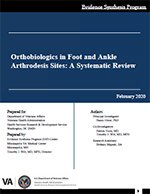
|
Prepared by: Recommended citation: |
Download PDF: Complete Report, Executive Summary, Report, Appendices
Arthrodesis of the ankle, hindfoot, and midfoot joints is an operative treatment for patients with severe pain or disability caused by arthritis, degenerative joint disease, trauma, congenital deformity, Charcot neuropathy, and other conditions. However, reported rates of nonunion following foot and ankle arthrodesis range from 0 to 36% with an average of 10 to 11%.
Nonunion following arthrodesis surgery is associated with poor function, disability, and the potential need for revision surgery. A number of factors have been reported to be associated with nonunion including patient factors, local factors at the site of surgery, and surgical factors.
Orthobiologics are biologically derived materials that may be used, in the context of arthrodesis, to promote bone formation and union at the arthrodesis site. Autograft, harvested from the iliac crest, tibia, calcaneus, or other sites, is considered the "gold standard" orthobiologic given that it possesses all 3 of the critical properties for bone healing: osteoconduction, osteoinduction, and osteogenesis.
Autograft has the advantages of minimizing risk of an immunologic response or infection that might occur with a donor product and is available at no cost (other than costs associated with harvesting the graft). However, the quantity of graft material is limited and there are potential complications, including the need for a separate incision site if a distant harvest site is chosen, longer operating time, nerve or vascular damage at the harvest site, and stress risers resulting in increased risk of bone fracture.
Other orthobiologic products have been considered for use in arthrodesis. Of interest for this review are non-structural products including osteoinductive products (eg, platelet-derived growth factor [PDGF], demineralized bone matrix [DBM], bone morphogenetic proteins [BMP], platelet-rich plasma [PRP]) and osteogenic products (eg, bone marrow aspirate [BMA]). Concerns with manufactured products include variability in manufacturing and differences across products in the same class due to proprietary preparation methods.
The purpose of our review was to examine the evidence from studies comparing use of an orthobiologic to no orthobiologic in primary foot (forefoot and proximally) and ankle arthrodesis procedures. Our focus was on non-structural autogenous orthobiologics.
1) What are the effectiveness and harms of adding orthobiologics compared to no orthobiologics when performing primary foot/ankle arthrodesis surgery?
1a) Do effectiveness and harms vary by patient age, gender, smoking status, obesity, diabetes, bone quality, arthrodesis site, or use of medications that may impede healing (eg, immunosuppressives)?
2) What is the cost and/or cost-effectiveness (as reported in the literature) of adding orthobiologics compared to no orthobiologics when performing primary foot/ankle arthrodesis surgery?
Orthobiologics in Foot and Ankle Arthrodesis Sites: A Systematic Review (Management eBrief)